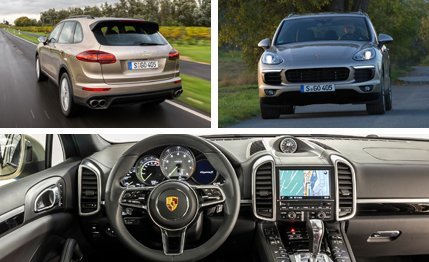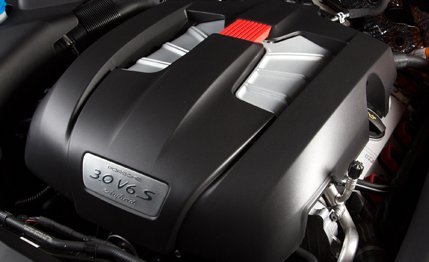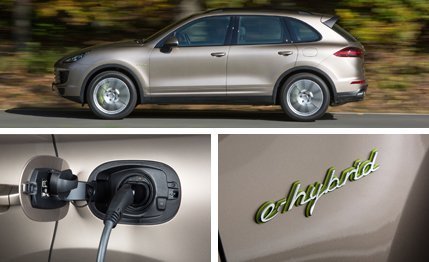
 First Drive Review
First Drive Review
If anyone predicted Porsche would be one of the brands leading the charge on plug-in hybrids back when Chevrolet launched the Volt in 2010—just as Porsche was debuting its first-ever production hybrid with the Cayenne—that person should be dealing futures on Wall Street. By replacing that SUV with this 2015 Cayenne S E-Hybrid plug-in, Porsche now has three plug-ins, more than any other carmaker. Of course, one of those three is the 918 Spyder, which isn’t exactly mainstream production. But still.
To get the Cayenne to plug-in status, Porsche basically grafted in the Panamera E-Hybrid’s high-voltage battery, electric motor, and power electronics, upping the lithium-ion battery capacity to 10.8 kWh from the sedan’s 9.4. Otherwise, the powertrain is identical, from the Audi-sourced supercharged 3.0-liter V-6 to the Aisin eight-speed automatic. Torque is routed to all four wheels via a limited-slip center differential with a rear-biased (58-percent) torque distribution.


The rest of the car is identical to the recently revamped Cayenne, with a few exceptions. The 282-pound battery, consisting of 104 individual cells, consumes the space normally reserved for a spare tire. Versus other Cayennes, the $77,395 E-Hybrid has two additional buttons on its center console. Selecting “E-Charge” prioritizes replenishing a depleted battery so future electric driving is possible. This increases fuel consumption by about 20 percent, according to Porsche. In “E-Power” mode, though, the Cayenne moves solely on the single electric motor at speeds up to 78 mph. This ability is largely aimed at European markets, where it allows owners to avoid congestion fees in certain cities. Americans will be able to use this silent-running mode to sneak up on friends or, at the very least, valets.
Every time the Cayenne starts, it’s in E-Power mode by default, assuming there is enough juice in the battery. Porsche claims that charging with a 240-volt hookup takes about three-and-a-half hours with the standard 3.6-kW charger; an optional 7.2-kW unit can cut that to 90 minutes if you have access to a high-voltage feed.


Driving in a city makes it hard to wish for more power than the electric motor produces. Maximum acceleration with all 416 gas-and-electric horses should return a zero-to-60-mph sprint well below six seconds, and a quarter-mile will pass in just over 14 ticks, according to Porsche. No too shabby for a two-and-a-half ton ute.
What’s more impressive is how the E-Hybrid stops, or rather how it decelerates. The regenerative braking actually has some modulation in the pedal and doesn’t operate with the on/off action of some other hybrids. It’s a light at the end of a long and dark tunnel of nonlinear hybrid brake feel. It isn’t perfect, and what feel there is remains meager, but it’s an exciting step for enthusiasts and evidence that electrification isn’t the end of all things fun.


There are few dynamic measures by which the Cayenne S doesn’t dominate the SUV world, and that trait survives in the plug-in. A stiff structure fortifies taut body control. Inspired driving doesn’t raise questions about the vehicle’s abilities, only the driver’s. Air springs, a $1990 option, trim ride height for fuel economy without cutting into the 7716-pound tow rating.
U.S.-market fuel-efficiency figures are not yet final, but we expect the EPA’s estimate of electric-only range to be about 14 miles, maybe a little more. On our drive, we saw more than 20 miles on battery power alone, after which the car reverts to normal hybrid-mode operation. City and highway fuel-economy ratings should be about 21 and 26 mpg, up from 20/24 in the previous Cayenne S Hybrid.
Considering Porsche’s all-in campaign of a hybrid endurance racer, it shouldn’t be surprising that Porsche makes hybrids that appeal to drivers. It makes us wonder where Toyota’s roadgoing hybrids would be if it had started racing its hybrid technology 10 years earlier.